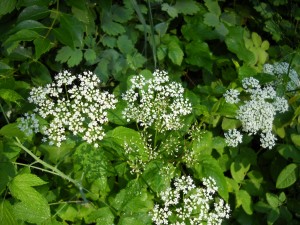Weeds … Alien Invaders or Plants Just Looking for a New Home?
It’s winter, and I have time to get caught up on my reading. When I was in Wales last fall I made a book-lovers pilgrimage to Hay-on-Wye. This is a town of 1,500 to 2,000 souls with at least 28 independent bookstores, mostly stores selling used books. That’s about a bookstore for every 50 people living there! Needless to say, it attracts lots of booklovers, especially in June when it has a book festival.
I spent 2 days poking around bookshops looking for weird and wonderful books and found plenty. Among them was a book on weeds, Weeds: The Story of Outlaw Plants by Richard Mabey (Profile books, 2010).
The author is a British nature writer with an interest in plants, especially weeds. Weeds, he explains, are opportunists. Cities are full of weeds growing in the most unlikely places: between the cracks of the sidewalks or walls, in abandoned lots – and once a weed seed even germinated in someone’s eye! Wherever they find a niche, they grow. Many can produce large numbers of seeds or are able to spread by roots that wander; most have arrived from distant countries.
We gardeners know, as he points out, that weeds move in when we disturb the soil – to plant a tomato or to create a flower garden. But a weed, according to Mabey, is just a plant growing where we want to grow something else, or nothing at all. I liked his quote from Ralph Waldo Emerson that a weed is “a plant whose virtues have not yet been discovered”.
In late fall I got an email from a friend asking me to identify a weed that had been troublesome in his cold frame. “I attach an image, as I do not even know the name of this curse to the garden world, this Medusa which has been defying eradication. Can you put a name to this curse with an idea how to best cope with it?”
I told him that his bane was chickweed (Stellaria media), and that it is edible – some people use it like lettuce or steam it like spinach. Once he knew that, he changed his attitude 180 degrees. Which is lucky, as he did some research and found that chickweed can bloom 5 times per year with each plant producing up to 20,000 seeds that can remain viable in the ground up to 40 years. He emailed that, “I guess I might as well enjoy the fact that it is edible and is most profuse at a time of the year (early December) when there is not much else edible growing vibrantly.”
But back to Richard Mabey’s book on weeds. I learned that Kentucky bluegrass is not originally from Kentucky, but arrived from Europe where it is a not-very-prominent meadow grass. But it found different conditions here in the new world, and thrived.
Speaking of lawns, some gardeners, I think, could enjoy life a lot more if they accepted weeds a little more. I’m pretty lax about weeds in my lawn – I don’t remove them unless, like thistles, they can hurt bare feet. If they’re green and can be mowed, they’re okay by me. I like dandelions, I think they’re cheerful. I don’t understand the desire to poison them or dig them out.
In another bit of trivia, I learned that the common burdock (Arctium lappa) inspired a Swiss inventor, George de Mestral, to create velcro. According to Mabey’s book, Mestral came back from a walk with his dog and studied the burrs attached to its fur – and realized that it could be copied in nylon. He patented Velcro in 1951.
Weeds, Mabey pointed out, are highly adaptable. In a relatively few generations they can modify their color, height, or seed size to fit in with agricultural crops – disguising themselves, as it were, to avoid being eliminated. And some are positively vicious. Field bindweed (Convolvulus arvensis), which resembles morning glories, not only monopolizes soil nutrients, it exudes pheromones that inhibit germination of most grain crops. Quack grass (Agopyron repens) produces a toxin that can poison corn.
But many “weeds” invade our spaces and become a part of our acceptable plant palette. The state flower of Vermont is red clover, which is not a native flower, for example. Mabey is all for giving “naturalized” citizenship to those weeds that can be useful to us, like that chickweed mentioned above. There are just a few that he singles out as truly scary.
First on the scary list is kudzu, a Japanese vine that has become a real pest down South. Unless/until global warming gets much worse, we don’t have to worry about it here. But we have Japanese knotweed, also known as bamboo. He says an insect predator is being tested in England as a way to control it, but at present there really is no easy way to get rid of it– even for gardeners who are willing to use chemical poisons on it. And he writes about my nemesis, goutweed (Aegopodium podagraria). Ugh! I thought I had beaten it once by digging it all out and replacing 12 inches of soil, but after a few years it came back.
So enjoy your winter, and try not think about the weeds that are just waiting, like us, for spring. Either that, or get your house ready to go on the market if you have goutweed or Japanese knotweed.
Henry Homeyer is the author of a new children’s book, Wobar and the Quest for the Magic Calumet. His web site is www.henryhomeyer.com.



